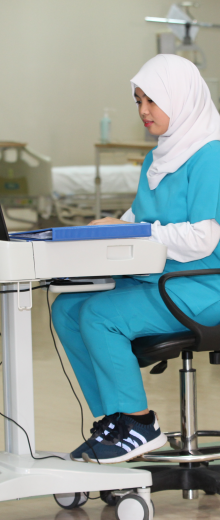What is Haemodialysis?
The Kidneys filter blood from the toxins and waste products produced in our bodies. The product of this filtration is urine. Kidney function can deteriorate due to disease and once that functionality falls below 10% to 15% it is a clear signal that the kidneys no longer have the ability to filter the blood. The result of this malfunction is the rapid increase of unwanted toxins and extra fluid in the body. Modern science presents us with a methods that can mimic the kidney function and keep the body functioning as close to normal as possible. Hemodialysis is one such procedure. During hemodialysis, the role of the kidney is replaced by a system that uses a man-made filter to remove the waste and a circuit which introduces a mixture of electrolytes (sodium, potassium, bicarbonate, chloride, calcium, magnesium and phosphate) to re-balance those which are lost during the filtration process.
What happens during a haemodialysis session?
During hemodialysis, blood is pumped by a machine through a circuit which includes a dialyzer, acting as the artificial kidney to filter the blood, and back into the body again. On average, an adult human has around 5 to 6 liters of blood. During the process of hemodialysis around 0.5 liters of blood is outside of the body at any given time.
To access the blood in a patient’s body, there are three available options for hemodialysis: arteriovenous (AV) fistula, AV graft and central venous catheter. The most preferred method is the AV fistula.
When the patient arrives at the clinic for a hemodialysis session, the nurse will check vital signs and take note of the patient’s weight. The amount of weight gained since the last will determine the amount of extra fluid the patient needs to have removed during the session which is about to commence. The patient then takes their place on the bed and is prepared to be connected to the dialysis machine.
Patients with a vascular access (AV fistula or AV graft) will receive two needles in their access point; one needle to carry blood out of the body and the other needle returns the blood to the body. Patients who have a catheter have the two tubes connected to the blood circuit that carries blood to the dialyzer and back into the body. When the patient is connected correctly, the dialysis machine is set and treatment can start.
The patient’s blood never actually touches the dialysis machine. The dialysis machine acts as a pump with computer controls. It monitors the flow of blood, blood pressure, the amount of waste fluid that is removed and other medical information. It mixes the dialysis solution to rebalance the electrolytes and sends the waste product safely to the drain. The dialysis machine provides ability to set the rate of flow of blood while it is being pumped through the circuit. The dialysis machine has safety detection features to warn the nurse or doctor if anything is wrong by way of audible and visual alarm.



